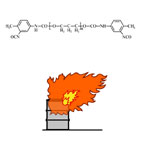| Case Name |
Self-ignition of soft urethane foam on restarting operation after maintenance at a depot |
| Pictograph |

|
| Date |
March 24, 1966 |
| Place |
Atsugi, Kanagawa, Japan |
| Location |
Chemical factory |
| Overview |
Fire ignited from soft polyurethane foam soon after foaming in a depot. The nozzle sending the raw material choked. When operation restarted after cleaning the nozzle, there were some parts where the mixing rate of raw materials was irregular and it caused a strong exothermic reaction. The damage increased as there was no sprinkler system in the factory. |
| Incident |
Fire occurred from soft polyurethane foam soon after foaming in a block depot. |
| Processing |
Manufacturing |
| Individual Process |
Maintenance |
| Chemical Reaction |
Polymerism |
| Substance |
Polyurethane, Fig2 |
| Type of Accident |
Fire |
| Sequence |
1. Among the spray nozzles that send raw material to the mixing head, the one sending isocyanate choked.
2. Operation restarted after stopping the reaction and cleaning the nozzle.
3. Fire occurred from the soft polyurethane foam soon after foaming in the block depot |
| Cause |
There was an abnormal part into which a large quantity of isocyanate flowed after restarting operation. The products molded with this irregular composition caused a strong exothermic reaction, accumulated heat, and ignited spontaneously. The damage increased as there was no sprinkler system in the factory. |
| Countermeasures |
Standardization of the operational procedure. |
| Knowledge Comment |
Operating conditions of equipment after maintenance are not always the same as those before the maintenance. Thorough double-check of conditions is required. |
| Background |
The operational procedure was not observed. |
| Incidental Discussion |
Plastic easily accumulates heat when its surface area increases, even if it does not have a molecular structure that is easily oxidized. The risk increases when it is preheated. (Material risk). |
| Reason for Adding to DB |
Example of composition change due to insufficient maintenance |
| Scenario |
| Primary Scenario
|
Organizational Problems, Poor Management, Slackness of Management, Carelessness, Insufficient Understanding, Insufficient Recognition of Risk, Ignorance, Insufficient Knowledge, Convincement, Usage, Maintenance/Repair, Check andCleaning, Regular Operation, Nonobservance of Procedure, No Check after the End of Maintenance, Bad Event, Chemical Phenomenon, Heat Generation/Ignition, Secondary Damage, External Damage, Fire, Loss to Organization, Economic Loss, Direct Monetary Damage 60 million yen
|
|
| Sources |
Japan Assoc of Fire Science and Engineering. Chemical fire committee. B.5.1. The polyurethane foam. Case 83. Chemical fire examples (1). pp. 100-101(1971).
Masamitsu Tamura, Masahide Wakakura. Spontaneous ignition of the soft urethane foam. The reaction danger. -Accident case and analysis- p.115(1995).
|
| Physical Damage |
About 80% of a one-story steel factory burned down. |
| Financial Cost |
¥60 million. (Chemical fire committee) |
| Multimedia Files |
Fig2.Chemical Formula
|
| Field |
Chemicals and Plants
|
| Author |
WAKAKURA, Masahide (Kanagawa Industrial Technology Research Institute)
TAMURA, Masamitsu (Center for Risk Management and Safety Sciences, Yokohama National University)
|